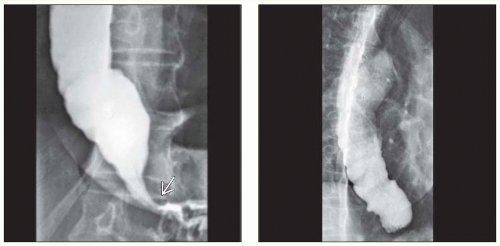Esophageal Motility Disturbances
Michael P. Federle, MD, FACR
Key Facts
Imaging
Primary: Achalasia, diffuse esophageal spasm, presbyesophagus
Secondary: Scleroderma, various causes of esophagitis
Achalasia: Idiopathic or neurogenic disorder
Markedly dilated esophagus; absent primary peristalsis
“Bird-beak” deformity in esophagogastric region
Diffuse esophageal spasm (DES)
Contractions are repetitive, esophageal lumen may show “corkscrew” or “rosary bead” pattern
Often with chest pain during contractions
Presbyesophagus or NEMD: Multiple aperistaltic (tertiary) contractions and ↓ primary peristalsis
Scleroderma
Patulous GE region and reflux → fusiform distal peptic stricture; ± hiatal hernia
Absence of peristalsis in lower 2/3 of esophagus
Top Differential Diagnoses
Reflux esophagitis
Esophagitis may impair peristalsis
Fundoplication complications (especially in elderly)
Esophageal (or gastric fundus) carcinoma
Postoperative state, esophagus
Vagotomy may impair peristasis
Esophagectomy with gastric conduit
Diagnostic Checklist
Correlate: Clinical, radiographic, and manometric findings
Patients with esophageal dysmotility often complain of food sticking in cervical esophagus
Intermittent cricopharyngeal spasm identified, but not primary dysfunction
TERMINOLOGY
Definitions
Primary and secondary motility disorders of esophageal smooth muscle
IMAGING
General Features
Best diagnostic clue
Achalasia: “Bird-beak” deformity; dilated esophagus with smooth, tapered narrowing at GE junction
Scleroderma: Dilated atonic esophagus with distal stricture
Other general features
Classification of esophageal motility disorders
Primary: Achalasia, diffuse esophageal spasm, presbyesophagus
Secondary: Scleroderma, various causes of esophagitis
Achalasia: Idiopathic or neurogenic disorder
Absence of primary peristalsis
Simultaneous low-amplitude contractions
May have prominent tertiary contractions (“vigorous achalasia”)
Increased or normal resting lower esophageal sphincter (LES) pressures
Incomplete or absent LES relaxation on swallowing
Normal upper esophageal sphincter
Diffuse esophageal spasm (DES): Related to varying degrees of neurogenic damage
Simultaneous contractions and intermittent primary peristalsis
Repetitive or prolonged-duration contractions
High amplitude and frequent spontaneous contractions
Normal LES function with complete sphincter relaxation during swallowing
Intermittent disruption of primary peristalsis associated with focally obliterative simultaneous contractions
Presbyesophagus: Esophageal motility dysfunction associated with aging
Also called nonspecific esophageal motility disorder (NEMD)
Decreased frequency of normal peristalsis
Increased frequency of aperistaltic contractions
Less commonly, incomplete LES relaxation
Scleroderma: Multisystemic disorder of small vessels and connective tissue
Decreased or absent resting LES pressure
Absent peristalsis in lower 2/3 of esophagus
Other esophagitises: Reflux, infectious, caustic
Irritated esophageal mucosa often results in abnormal peristalsis
Stay updated, free articles. Join our Telegram channel

Full access? Get Clinical Tree








